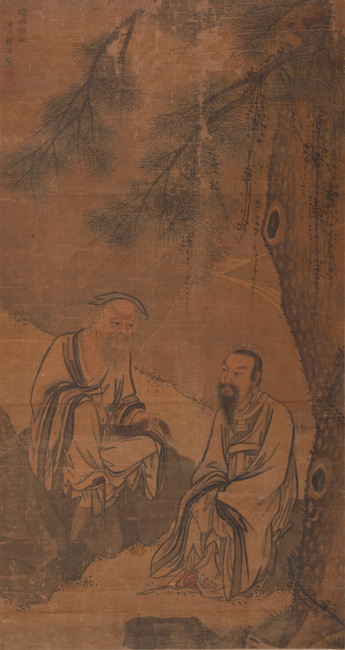-
From Current Issue
-
- Editor’s Letter Fire in the Heart
- Reviews I Gusti Ayu Kadek Murniasih
- Reviews 11th Seoul Mediacity Biennale: “One Escape at a Time”
- Dispatch Networked China
- One on One Monira Al Qadiri on Yukio Mishima
- Essays The rise of independent art spaces in pandemic-era Shanghai
- Features Tuan Andrew Nguyen
- Table of Contents
- Web Exclusives
- Archive
- Subscribe

R
E
V N
E
X
T
WU QINGYUN, Haizhou, 1892, ink and color on paper, 96 × 179 cm. All images courtesy Central Academy of Fine Arts (CAFA), Beijing.
“The Creation of Ancient Impression,” the online exhibition of Beijing’s Central Academy of Fine Arts (CAFA) Museum, displayed the institution’s collection of 91 Ming (1368–1644) and Qing-dynasty (1644–1912) paintings in an examination of gu—a romanticized ancient past. Gu encompasses attitudes of shared virtues, civilization, and political rule permeating every aspect of life with reverence for ancestry and traditions. Showcased via a panoramic interface that mimics IRL exhibitions, viewers started outside CAFA, while the virtual interior was realistic down to the woodgrain of the flooring, with each scroll scanned in high resolution. With the format itself representing innovation, the exhibition traced a historic narrative of Chinese paintings that evolved from imitation to renewal.
Screenshot of online viewing room for “The Creation of Ancient Impression,” at CAFA Art Museum, Beijing, 2020.
The first section, “Worship of the Ancient Neo-Confucianism,” presented works devoted to Song-dynasty (960–1279) thoughts that merged Confucian, Taoist, and Buddhist beliefs focused on self-cultivation, social etiquette, and political rule. Fu Tao’s Seeking Tao on Kongtong Mountain (early Qing) references China’s mythical and exemplar emperor Huangdi (27th-century BC) who supposedly asked Taoist deity Guangchengzi, who lived for a millennium, for political advice. In Fu’s detailed portrayal, the deity is seated above Huangdi as a figure of gu. Stylistically, the bold, flowing lines recall the Ming-dynasty Zhe School, which revived the revered Song-dynasty Ma-Xia landscapes, including the depiction of an overhanging pine tree on one side in Fu’s composition.
The section “Inheritance of the Literati Painting” turned to the Ming-dynasty Wu School, which reintroduced literati painting—a Song form of expressive painting that valued spontaneity—to Ming royals and intellectuals who valued the detailed realist style of gongbi painting. Lu Zhi’s Peach Blossom Land (1565) visualizes Tao Yuanming’s iconic book, (The Record of the) Peach Blossom (421) in his work: a small figure of a fisherman at the foot of the scroll happens upon a secluded, idyllic village which, in Lu’s rendition, is situated in a tree-lined valley. In Tao’s tale, the fisherman notifies the emperor of the community’s existence in hopes of being rewarded, only to find that the grotto has disappeared. While encompassing a yearning for a non-existent utopia mirroring the artist’s own inclination for escapism, Peach Blossom Land also critiques the corruption of the late Ming government. By drawing upon the ancient story, Lu contemplates his present predicament via the past.
The final part of the exhibition, “Transformation of the Ancient to the New,” documented innovative metamorphoses of gu. In one of these works, Haizhou (1892) by Wu Qingyun, depicting the historic city of Jiangsu, was painted over four vertical sheets of paper and contain an amalgamation of Chinese and Western styles. While the scene of the traditionally popular mountainscape reveal a level of detail reminiscent of gongbi, other elements suggest Western influence such as the realism portrayed via the shadows and textures of the mountainous background. Done via crosshatching thin, light brushstrokes rather than large swathes of ink, the dark peaks recall the European technique of hatching. Meanwhile, the pavilions amid the mountains are depicted using the Western, fixed perspective. As a forerunner of the late 19th to 20th century Shanghai style, which combines Chinese and Western techniques, Wu innovates manifestations of gu through reinterpretations of the traditional.
“The Creation of Ancient Impression” embodied the idea of history repeating itself, whether shown through the repetitive stylistic choices the artists made or the reoccurring sociopolitical issues their works explored. At the same time, the exhibition itself plays a part in the creation and renewal of gu via its simulated digital gallery. Throughout 2020, it has become clear that the issues we face today are inextricable from the past and possibly even a reiteration of it. Amid political instabilities, economic plummets, and a deadly pandemic, there is no better time than now to acknowledge the past and ask: what can our histories and roots tell us about our present, and possibly our future?
“The Creation of Ancient Impression” is on view at the website of CAFA Art Museum, Beijing, until December 31, 2020.
To read more of ArtAsiaPacific’s articles, visit our Digital Library.
















